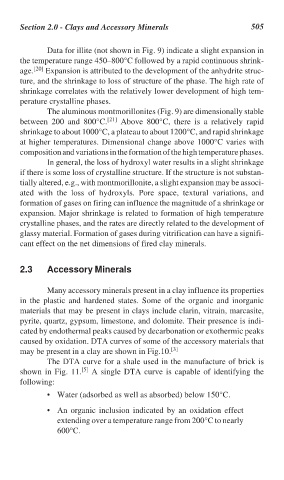Page 534 - Handbook of Thermal Analysis of Construction Materials
P. 534
Section 2.0 - Clays and Accessory Minerals 505
Data for illite (not shown in Fig. 9) indicate a slight expansion in
the temperature range 450–800°C followed by a rapid continuous shrink-
age. [20] Expansion is attributed to the development of the anhydrite struc-
ture, and the shrinkage to loss of structure of the phase. The high rate of
shrinkage correlates with the relatively lower development of high tem-
perature crystalline phases.
The aluminous montmorillonites (Fig. 9) are dimensionally stable
between 200 and 800°C. [21] Above 800°C, there is a relatively rapid
shrinkage to about 1000°C, a plateau to about 1200°C, and rapid shrinkage
at higher temperatures. Dimensional change above 1000°C varies with
composition and variations in the formation of the high temperature phases.
In general, the loss of hydroxyl water results in a slight shrinkage
if there is some loss of crystalline structure. If the structure is not substan-
tially altered, e.g., with montmorillonite, a slight expansion may be associ-
ated with the loss of hydroxyls. Pore space, textural variations, and
formation of gases on firing can influence the magnitude of a shrinkage or
expansion. Major shrinkage is related to formation of high temperature
crystalline phases, and the rates are directly related to the development of
glassy material. Formation of gases during vitrification can have a signifi-
cant effect on the net dimensions of fired clay minerals.
2.3 Accessory Minerals
Many accessory minerals present in a clay influence its properties
in the plastic and hardened states. Some of the organic and inorganic
materials that may be present in clays include clarin, vitrain, marcasite,
pyrite, quartz, gypsum, limestone, and dolomite. Their presence is indi-
cated by endothermal peaks caused by decarbonation or exothermic peaks
caused by oxidation. DTA curves of some of the accessory materials that
may be present in a clay are shown in Fig.10. [3]
The DTA curve for a shale used in the manufacture of brick is
[5]
shown in Fig. 11. A single DTA curve is capable of identifying the
following:
• Water (adsorbed as well as absorbed) below 150°C.
• An organic inclusion indicated by an oxidation effect
extending over a temperature range from 200°C to nearly
600°C.

